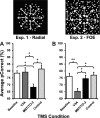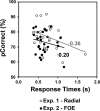Differential processing of the direction and focus of expansion of optic flow stimuli in areas MST and V3A of the human visual cortex
- PMID: 28298300
- PMCID: PMC5454473
- DOI: 10.1152/jn.00031.2017
Differential processing of the direction and focus of expansion of optic flow stimuli in areas MST and V3A of the human visual cortex
Abstract
Human neuropsychological and neuroimaging studies have raised the possibility that different attributes of optic flow stimuli, namely radial direction and the position of the focus of expansion (FOE), are processed within separate cortical areas. In the human brain, visual areas V5/MT+ and V3A have been proposed as integral to the analysis of these different attributes of optic flow stimuli. To establish direct causal relationships between neural activity in human (h)V5/MT+ and V3A and the perception of radial motion direction and FOE position, we used transcranial magnetic stimulation (TMS) to disrupt cortical activity in these areas while participants performed behavioral tasks dependent on these different aspects of optic flow stimuli. The cortical regions of interest were identified in seven human participants using standard functional MRI retinotopic mapping techniques and functional localizers. TMS to area V3A was found to disrupt FOE positional judgments but not radial direction discrimination, whereas the application of TMS to an anterior subdivision of hV5/MT+, MST/TO-2 produced the reverse effects, disrupting radial direction discrimination but eliciting no effect on the FOE positional judgment task. This double dissociation demonstrates that FOE position and radial direction of optic flow stimuli are signaled independently by neural activity in areas hV5/MT+ and V3A.NEW & NOTEWORTHY Optic flow constitutes a biologically relevant visual cue as we move through any environment. With the use of neuroimaging and brain-stimulation techniques, this study demonstrates that separate human brain areas are involved in the analysis of the direction of radial motion and the focus of expansion in optic flow. This dissociation reveals the existence of separate processing pathways for the analysis of different attributes of optic flow that are important for the guidance of self-locomotion and object avoidance.
Keywords: V3A; V5/MT+; fMRI; psychophysics; transcranial magnetic stimulation.
Copyright © 2017 the American Physiological Society.
Figures





References
MeSH terms
Grants and funding
LinkOut - more resources
Full Text Sources
Other Literature Sources

